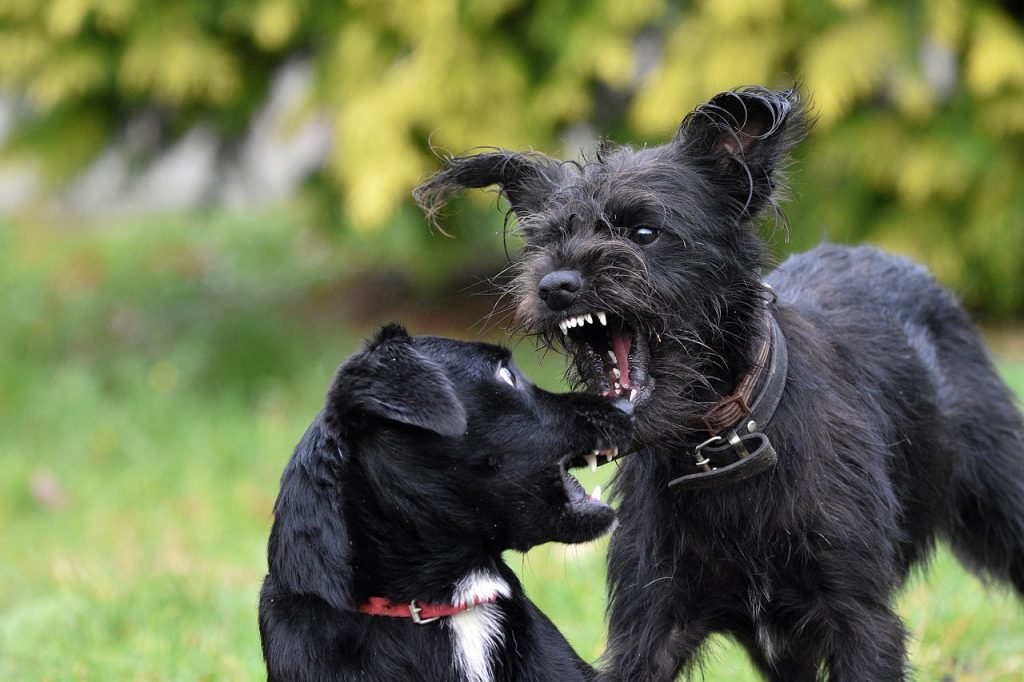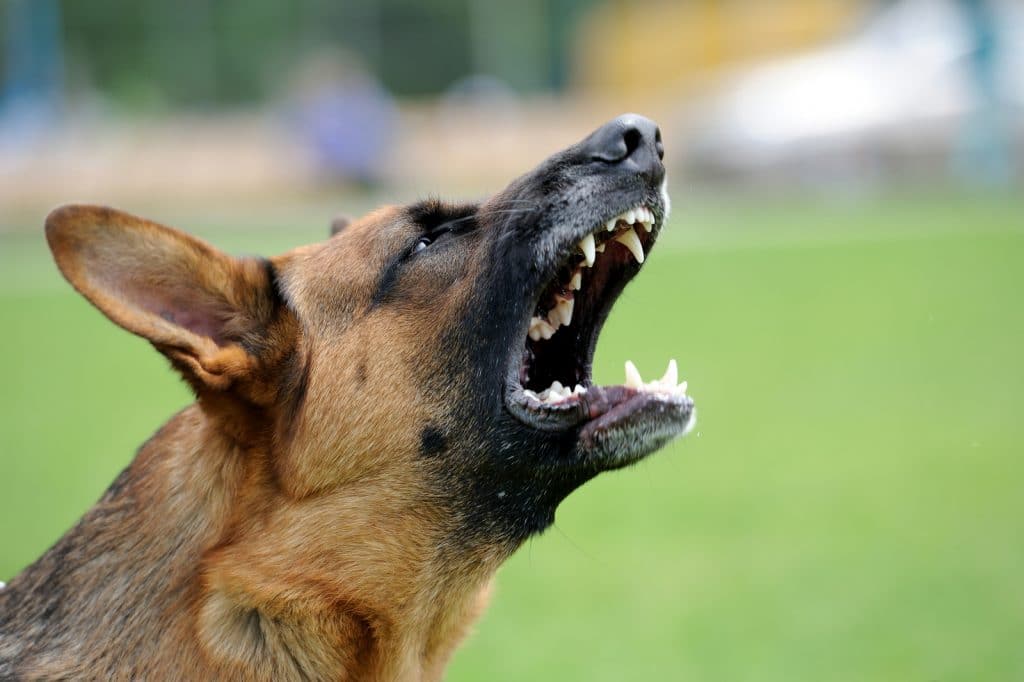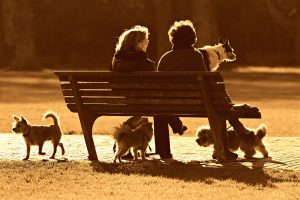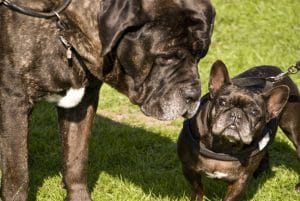![]()
HeelBoyHeel is reader supported. When you buy through any link on our site, we may earn an affiliate commission, but never at any extra cost to you.

Aggression between dogs is common but this does not make it any less serious.
Every dog owner wants a dog who is well behaved in social situations. Nobody wants to be on the other end of the leash attached to a growling, snarling hound. This could be on a walk in the countryside, in the park, under a table in a restaurant, or (if you have more than one dog), in your own home.
However, for dogs and most animals, (this includes us), aggression is usually a result of stress or fear.
What Causes Dog-To-Dog Aggression?
The usual causes of aggression in dogs are the result of a previous trauma or lack of socialization. A puppy who has experienced abuse or neglect when young or has had a bad encounter with another dog may find it difficult to relax in the company of other dogs. Positive social interaction with other pups and dogs helps to build your dog’s confidence when meeting other dogs. A lack of socialization can result in a nervous dog, which, in turn, may result in an aggressive dog.
However, there are certain medical conditions that can be the cause of your dog becoming aggressive towards other dogs. If your dog has previously shown no signs of aggression, than this is a good time to visit your vet.
Common Causes Of Aggression Between Dogs
 We all have certain things that make us feel uneasy, threatened or downright annoyed. The friend who stands too close when talking to you, the friend who feels it’s acceptable to be insulting and critical of your family, (after all, that’s your job!), the friend who believes that what is yours is also his or hers, the list is individual and endless.
We all have certain things that make us feel uneasy, threatened or downright annoyed. The friend who stands too close when talking to you, the friend who feels it’s acceptable to be insulting and critical of your family, (after all, that’s your job!), the friend who believes that what is yours is also his or hers, the list is individual and endless.
Your dog will also have certain triggers that may provoke an aggressive response. By identifying the trigger or triggers, you will be in a better position to help your dog.
One of the most common reasons is your dog defending his or her own territory, territorial aggression. This is deep rooted in all dogs, (although not in puppies), and usually results in quite a bit of barking. However, for some dogs another dog entering his or her territory is seen as a very real threat and may lead to aggressive behaviour.
So, you’ve done a good job and your dog feels like one of the family – no matter the size of the family or how many legs each family member may possess. Along with this comes your dog’s natural instinct to protect his or her family pack. For some dogs, another dog coming too close to his or her pack may result in protective aggression.
Another common cause of aggression towards other dogs is possessive aggression. The trigger for possessive aggressive dogs is when another dog, (or person) gets too close to something they see as theirs. Although this is usually food or a dog treat that he or she is saving for later, it could be a dog toy or bed for example.
There are other causes, such as fear or frustration. Your job is to identify what upsets your dog and leads to aggressive behaviour.
How To Prevent Aggression Between Dogs
Stay In Control And Calm
When you see (or hear) the warning signs that your dog is either going to react to aggressive behaviour from another dog or instigate the bad behaviour, stay calm. More easily said than done! However, by staying calm, and particularly keeping a calm voice, you can still maintain a certain amount of control of the situation. By losing control you will only escalate the situation.
Block Your Dog’s View Of The Other Dog
If you see trouble coming, in the form of another dog and your dog has not seen the dog yet, then it is easy enough to change direction when out for a walk, or remove your dog to a different room, for example.
If this moment has passed and your dog is showing signs of aggression, then block his or her line of sight towards the oncoming problem. Get in front of your dog, so that his or her concentration is directed to you, if you feel it’s safe to do so, so that you can take control. If not, use the leash to redirect your dog. This is when a dog halter rather than a collar helps you to control your dog more easily and painlessly for your dog.
Neutral Meeting Places
As previously said, lack of socialization when a puppy can lead to underdeveloped social skills in an adult dog. This, in turn, may progress to aggression towards other dogs. However, you may have friends and family who have dogs and it would be great for you all to socialize, dogs included. This is also extremely important for your dog, he or she will learn to enjoy (or at least tolerate) the company of other dogs.
If this is going to work, you have to have a neutral place that is large enough for your dog and one other dog to avoid each other if they want. You don’t want to overload your dog with all your friends’ and family’s dogs at once. You can equate this to getting to know one person at an outside cafe, as opposed to being totally overwhelmed at a cocktail party where you know nobody.
Distraction
Mothers have been using distraction techniques with their terrible two year olds for ages and ages. ‘If you stop doing that, you can do/ have/play with this.’ It works, mothers are rarely wrong!
Guess what? Your dog has about the same mental age as a child of two and a half years of age. So, in the early stages of aggression, distract your dog from the other dog with something better, that he or she really likes.
Reasons Why Dogs Attack Other Dogs
Lack Of Socialization
 This is not just about a lack of socialization when your dog was a puppy. This also applies to older dogs who never get out and about.
This is not just about a lack of socialization when your dog was a puppy. This also applies to older dogs who never get out and about.
If your dog has never had the opportunity to mix with other dogs, he or she is going to feel very vulnerable and defensive when meeting new dogs and this may result in aggressive behaviour.
Fear Of Other Dogs
A frightened dog has two alternatives. The first option is to get away from the oncoming dog, which is not always possible. The second option is to respond with a show of aggression to keep the dog away. After having success with the second option a few times, he or she may use this defensive aggression as the first option.
Pack Mentality
If your family, (pack), has more than one dog, it can result in aggression issues. As with a wolf pack, one of your dogs, usually the oldest, will consider himself or herself the alpha. To maintain this position, he or she may resort to signs of aggression. Usually, a growl will be enough to keep other pack members under control. However, if the growl does not work, the situation can soon escalate.
Feeling Threatened By Another Dog’s Size
Most big dogs are gentle giants but try explaining this to a small dog who feels threatened by big dogs. Often this is unwittingly fostered by pet owners who have small dogs. Picking up a small dog or pup when a large dog is approaching is a positive reinforcement that there is something to be frightened of.
 The other side of the coin is the big dog who is annoyed by his or her owner’s attention being easily transferred to a cute small dog or puppy.
The other side of the coin is the big dog who is annoyed by his or her owner’s attention being easily transferred to a cute small dog or puppy.
Both of these situations can produce an aggressive dog, large or small, but usually small.
Being Confined To A Small Space
This frustration-elicited aggression is a combination of stress from being confined and as a consequence, not being able to say hello to another dog. This doesn’t just apply to a small fenced area in the back yard. For some dogs, this also means being on the end of a leash when another dog is approaching. This form of aggression may be directed to the approaching dog or the person on the other end of the leash.
Ways To Control And Fix A Dog Being Aggressive Towards Other Dogs
Control Your Natural Instincts
Everyone of us has a different response to aggressive behaviour, ranging between fear and anger. Neither of these two, or anything in between is going to help you or your dog.
Hopefully, you have trained your dog well and your dog looks to you as the ultimate pack leader. If you are able to control your natural instinct, (maybe to panic or over react!), your dog will still look to you for direction. The last thing your dog needs is for both of you to have aggression issues!
Help Your Dog To Learn Neutrality
An aggressive dog is also known as a reactive dog, meaning he or she reacts to a trigger, in this case, another dog. Teaching your dog neutrality helps him or her to reduce the reaction to other dogs, instead you will be the main focus of your dog’s attention.
This involves exposing your dog to other dogs and then using a treat to return your dog’s focus to you. As you can imagine, this needs to be a pretty special treat! For this to work, it has to be done at a distance far enough away from the other dog, so that your dog is only showing the first signs of aggression. If your dog becomes too stressed, he or she will not be distracted from the other dog, no matter how good the treat! In time your dog will be able to get closer to other dogs without having an aggressive reaction.
Learn To Understand And Read Your Dog’s Body Language
There are different signals for you to learn to identify how stressed your dog is when exposed to his or her particular trigger and consequently, how aggressive he or she may become.
In the first instance, your dog may stand still and alert, staring at the other dog. He or she is no longer interested in sniffing around and you may have to repeat the same command a few times to elicit a response. Now is the time to return your dog’s attention to you with the treat.
As your dog gets more stressed and excited, he or she will be pulling at the leash. He or she may growl or bark intermittently. By this stage, it will be difficult to return your dog’s focus to you, a treat is unlikely to work.
By the time your dog is barking continuously and lunging towards the other dog, the situation has become very serious. He or she will not be able to hear commands from you and you can forget the treats. Your dog will more than likely attack the other dog, given the chance.
Keep Greetings Short And Sweet
Although your best friend may be gaining confidence around other dogs, you still need to take care. Don’t put your dog in a position which may be too stressful.
So, now you may be able to say “Hey, hello” to a fellow dog owner. The temptation is to stop and talk but the situation may be stressful enough for your dog already, so the best idea is to keep going. After all, your best friend has done so well and a potential new friend can wait.
Conclusion
If you have read this far, then you have probably got a dog or know someone with a dog who can be aggressive towards other dogs.
If you have identified what triggers the aggressive behaviour in your dog, you are in a position to either remove the trigger or help him or her realize that it is not so bad after all. However, please remember that a trip to your vet to see if there are any health issues causing the aggressive behaviour, especially in an older dog with no previous anger issues, is not a wasted journey. You can also seek help from a professional dog trainer, who after identifying the problem, may be able to provide you with a plan of action.
So, another way to protect your dog is to invest in simple, but effective products. For example a good, strong harness will give you more control over your dog when he or she becomes aggressive and cause him or her less discomfort. A muzzle will prevent your dog from doing the wrong thing and give you a little piece of mind.
Please remember, that a dog who has shown aggression in the past can always respond to multiple triggers and revert to aggressive behaviour again.
There are plenty of dog owners who have the same problem, to differing degrees, and it’s a serious problem – you are not alone.
But take the right steps, and get the right help, and you WILL overcome this.